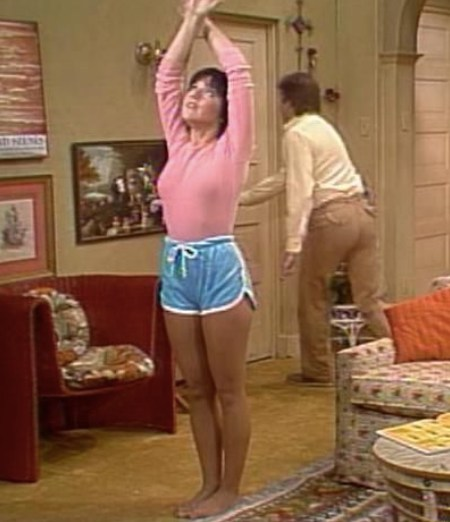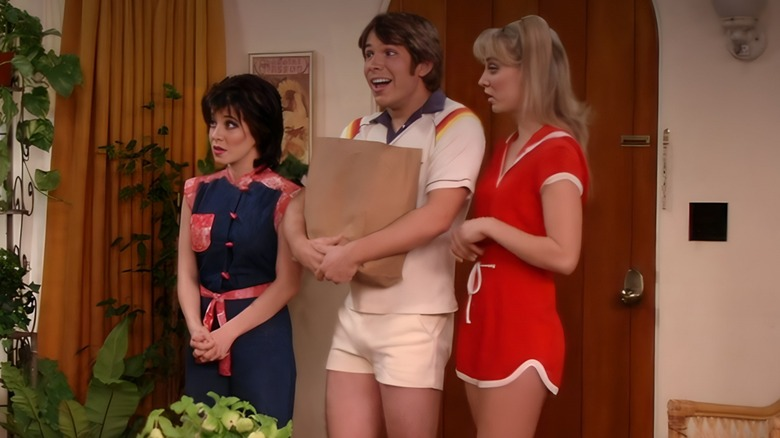“Three’s Company,” which graced television screens from 1977 to 1984, remains a shining gem in the world of sitcoms. This beloved show masterfully blended humor, relatable characters, and groundbreaking themes, captivating audiences for eight unforgettable seasons. Centered around three roommates navigating life in Santa Monica, California, the series offered laughs, heart, and a subtle challenge to societal norms.

Among its standout stars, Joyce DeWitt’s portrayal of Janet Wood captured viewers with her sharp wit, intelligence, and ability to keep the chaos of her quirky household in check. Let’s explore what made this show—and DeWitt’s performance—so unforgettable.
“Three’s Company” was far more than just another sitcom. It became a cultural touchstone by pushing boundaries in an era when television often played it safe. The premise? Jack Tripper (John Ritter), Janet Wood (Joyce DeWitt), and Chrissy Snow (Suzanne Somers) shared an apartment. However, Jack had to pretend to be gay to appease their conservative landlord, Mr. Roper.
This clever twist on living arrangements created endless comedic scenarios, but it also broke ground by portraying platonic relationships between men and women—something relatively unexplored on TV at the time. The show struck a chord with audiences, balancing slapstick humor with a fresh perspective on friendship and modern living.
If John Ritter’s Jack was the charming goofball and Suzanne Somers’ Chrissy was the bubbly blonde, Joyce DeWitt’s Janet was the glue holding it all together. As the level-headed and pragmatic roommate, Janet brought a sense of stability to the trio’s often chaotic escapades. She wasn’t just the “straight woman” in the comedic trio; her quick wit and impeccable timing made her a comedic powerhouse in her own right.
Janet Wood was more than just a roommate; she was the voice of reason amid Jack’s antics and Chrissy’s naïveté. She grounded the show with her relatability and charm, becoming a character that viewers could admire and root for. Her intelligence and strong moral compass often guided the group out of their various predicaments, making her a standout presence in every episode.
One of the most memorable moments in “Three’s Company” came from a single episode where Janet donned blue shorts and a pink blouse, an ensemble that perfectly captured the show’s vibrant energy and 1970s flair. This outfit, simple yet stylish, became an enduring visual symbol of Janet’s approachable and fun personality.
Fashion on the show was more than just clothing—it reflected the era’s evolving cultural landscape. Joyce DeWitt’s wardrobe often exuded confidence and practicality, mirroring her character’s grounded yet adventurous nature. That iconic outfit remains etched in fans’ memories, a snapshot of a time when sitcoms were colorful, carefree, and endlessly entertaining.
Joyce DeWitt’s comedic timing and energy were pivotal to the show’s success. She had a knack for reacting to absurd situations with a mix of exasperation and humor that made Janet feel authentic. Whether she was delivering a snarky comeback or rolling her eyes at Jack’s shenanigans, DeWitt’s performance brought depth and heart to her character.

Her chemistry with John Ritter and Suzanne Somers was electric, and their dynamic became one of the driving forces behind the show’s enduring appeal. The trio’s interplay created comedic gold, with Janet often playing the perfect foil to Jack’s hijinks and Chrissy’s whimsical misunderstandings.
“Three’s Company” wasn’t just about laughs; it was also a trailblazer in its own right. The show challenged the conventional portrayal of relationships on television, presenting a progressive take on cohabitation and platonic friendships. It subtly questioned societal norms, making audiences think even as they laughed out loud.
In an era where male-female dynamics on TV were often limited to romantic or familial relationships, “Three’s Company” dared to explore the complexities of friendship between men and women. Jack, Janet, and Chrissy weren’t defined by romantic entanglements but by their mutual respect, camaraderie, and shared misadventures.
This groundbreaking approach resonated with viewers and paved the way for future sitcoms to delve into similar themes, proving that laughter could also be a vehicle for change.

Decades after its final episode aired, “Three’s Company” continues to attract new fans, thanks to reruns and streaming platforms. Its humor remains timeless, its characters as lovable as ever. For many, the show is a nostalgic reminder of a simpler time when sitcoms brought families together around the TV.
Joyce DeWitt’s portrayal of Janet Wood remains a highlight of the series. Her character was a trailblazer in her own right, showing that women could be funny, smart, and independent without being overshadowed by their male counterparts. Janet’s blend of humor, heart, and relatability ensures that she remains a fan favorite to this day.
“Three’s Company” wasn’t just a sitcom; it was a cultural phenomenon that redefined television comedy. With its hilarious scenarios, groundbreaking themes, and unforgettable characters, it continues to hold a special place in the hearts of fans old and new. At the heart of this beloved series was Joyce DeWitt’s Janet Wood, whose intelligence, humor, and iconic style left an indelible mark on the show’s legacy.
Whether it’s the laughter, the nostalgia, or the progressive storytelling, there’s something about “Three’s Company” that keeps us coming back for more. So, the next time you’re looking for a dose of classic TV charm, remember Janet in her blue shorts and pink blouse—and let the laughter begin.